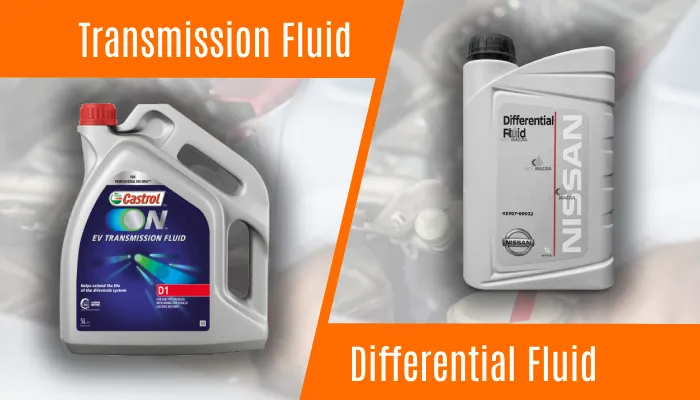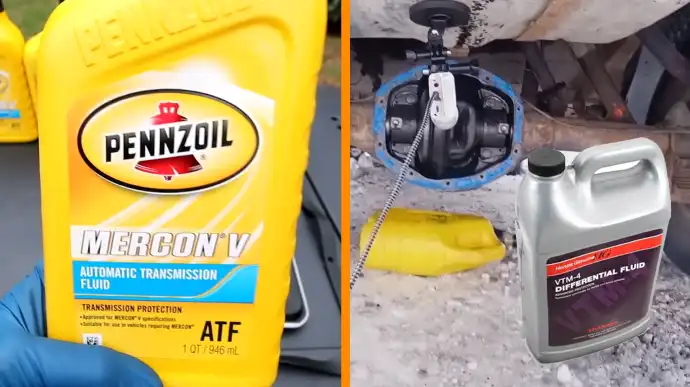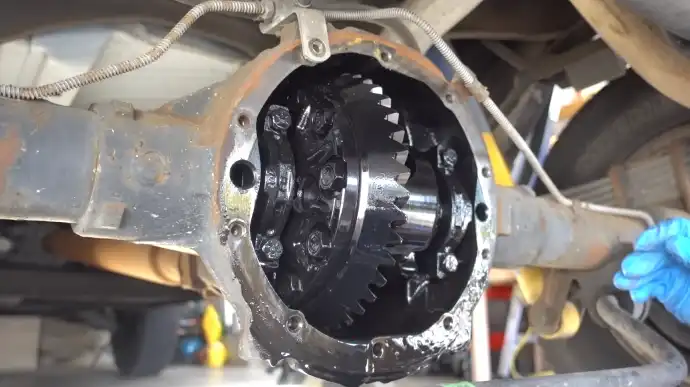Physical Address
304 North Cardinal St.
Dorchester Center, MA 02124
Physical Address
304 North Cardinal St.
Dorchester Center, MA 02124

Automotive maintenance and the use of the correct fluids are essential for the longevity and optimal performance of a vehicle. Among the various fluids that keep a vehicle running smoothly, transmission and differential fluids stand out due to their critical roles in the transmission system.
Transmission fluid is specifically designed for automatic transmissions. Its primary role is to lubricate the various components within the automatic transmission and facilitate smooth gear changes without user intervention.
Differential fluid, also known as gear oil, is intended for manual transmissions. It serves to lubricate the internal moving components and protect the gears, which are manually engaged by the driver using a clutch and gear shift.
Here, we will explore the key differences between transmission and differential fluids. Also provide their unique properties, applications, and the consequences of using the wrong fluid for your vehicle.

As it pertains to the differences between transmission fluid and differential fluid for your vehicle, there are several key points to consider.
Understanding the differences between transmission fluid and differential fluid is crucial to ensuring proper lubrication and protection of your vehicle’s internal components.
Transmission fluid is specifically formulated to lubricate the delicate components of automatic vehicle transmissions. It contains additives that help maintain the integrity of the transmission seals and prevent foaming. Additionally, transmission fluid provides cooling and helps facilitate smooth shifting between gears.
On the other hand, differential fluid is designed to lubricate the gears in manual vehicle transmissions. It’s thicker and has higher viscosity to withstand the higher loads and pressures exerted on the gears. Differential fluid also contains additives to reduce friction and prevent wear on the gears.
Transmission fluid has a lower viscosity compared to differential fluid. It typically falls in the range of 0W-5 to 5W-10, which allows it to flow smoothly in automatic vehicle transmissions. The lower viscosity helps with the efficient transfer of power between the engine and the transmission components.
Conversely, differential fluid is notably thicker, with a viscosity of around 7W-90. This increased thickness is necessary to withstand the higher heat and friction generated in manual transmissions.
With differential fluid’s thicker viscosity, gears and bearings are well lubricated and protected, minimizing wear and tear and ensuring smooth operation.
Fluids used in automatic transmissions contain additives designed specifically for them. These additives include detergents, essential for cleaning the intricate components of the transmission. They help prevent the build-up of debris and contaminants, ensuring smooth operation.
Additionally, transmission fluid also contains anti-foaming capabilities. This is crucial because automatic transmissions generate more heat and are prone to foaming. Foaming can lead to reduced lubrication and impaired transmission performance.
In contrast, the differential fluid used in manual transmission vehicles lacks these additives. It’s formulated to provide lubrication and protection to the gears within the differential without needing cleaning agents or anti-foaming properties.
Differential fluid typically requires replacement every 50,000 to 60,000 miles or when issues are detected. On the other hand, transmission fluid has a longer lifespan and should be checked every 30,000 to 100,000 miles.
The thicker consistency of gear oil contributes to its longer lifespan compared to the thinner transmission fluid, which may require less frequent changes. To ensure optimal performance and longevity, follow the manufacturer’s recommendations for fluid maintenance intervals.
Low differential fluid levels can lead to gear grinding and potential damage to the vehicle. This is because the differential is responsible for transferring power between the wheels, and without sufficient lubrication, the gears can wear down and cause grinding.
Alternatively, low transmission fluid levels can result in grinding noise, fluid leakage, burning smell, and slipping gears. The transmission is responsible for shifting gears and transmitting power, so when the fluid is low, the transmission can experience significant damage and malfunctions.
If you drive a semi-truck, you’ll need to understand the different uses of transmission fluid and differential fluid.
In semi-trucks, automatic transmission fluid is specially formulated. It has a low viscosity to ensure smooth shifting and proper lubrication of the transmission components. The transmission fluid also helps in transferring power from the engine to the wheels efficiently.
On the other hand, differential fluid is used in the truck’s differential, which is responsible for distributing power between the wheels. Differential fluid is thicker and has additives to better protect against heat and wear. It also helps reduce friction and prevent damage to the gears inside the differential.

You can easily distinguish between transmission fluid and differential fluid based on their respective roles in ensuring smooth gear transitions in your vehicle.
Transmission fluid is specifically designed to provide lubrication and hydraulic pressure to the various components of an automatic transmission. It’s formulated to reduce friction, heat, and wear, allowing the gears to shift seamlessly without any jerking or hesitation.
Meanwhile, differential fluid is used in the differential, which transfers power from the engine to the wheels. It’s designed to withstand high pressures and extreme conditions during cornering and turning.
The differential fluid also helps to reduce noise and vibration, ensuring a smooth and efficient power transfer to the wheels.
If differential fluid is used instead of transmission fluid, it can lead to clogging and reduced performance in automatic vehicle transmissions. Differential fluid is designed to lubricate and cool differential gears, while transmission fluid provides lubrication, cooling, and hydraulic pressure to the transmission.
On the other hand, using transmission fluid in a manual vehicle transmission may result in gear grinding, increased friction, and potential damage. It’s important to consult your vehicle’s manual or seek professional advice to use the correct fluid for each component.
Ignoring this important aspect can lead to costly repairs and compromised performance.
| Feature | Transmission Fluid | Differential Fluid |
| Purpose | Lubricate automatic transmission components | Lubricate manual transmission gears |
| Viscosity | Lower viscosity (0W-5 to 5W-10) for smooth flow | Higher viscosity (7W-90) for increased load |
| Additives | Detergents, anti-foaming agents | Limited additives for lubrication |
| Fluid Longevity | Longer lifespan (30,000 to 100,000 miles) | Requires more frequent changes (50,000 to 60,000 miles) |
| Symptoms of Issues | Grinding noise, fluid leakage, burning smell, slipping gears | Gear grinding, potential damage due to insufficient lubrication |
| Usage in Semi-Trucks | Low viscosity for smooth shifting and lubrication in automatic transmissions | Higher viscosity with additives for better protection in differentials |
| Ease of Gear Transition | Facilitates seamless gear shifts in automatic transmissions | Withstands high pressures during cornering and turning in differentials |
| Consequences of Incorrect Usage | Clogging, reduced performance in automatic transmissions | Gear grinding, increased friction, potential damage in manual transmissions |
| Maintenance Intervals | Checked every 30,000 to 100,000 miles | Replaced every 50,000 to 60,000 miles |
Transmission fluid is typically created using crude oil and undergoes chemical reactions to meet specific vehicle requirements. Transmission fluid is traditionally made from crude oil and reshaped into the desired specifications for each vehicle by reshaping hydrocarbons.
On the other hand, synthetic transmission fluid is produced through different chemical reactions, making it less likely to break down, oxidize, or thin out at high temperatures. Synthetic transmission fluid has become increasingly popular due to its superior performance and durability.
It provides better lubrication, reduces friction, and improves overall transmission efficiency. Additionally, synthetic transmission fluid offers longer service intervals, saving both time and money for vehicle owners.

To determine the amount of differential oil needed, refer to your vehicle owner’s manual for the recommended capacity. The manual will provide the exact specifications for your specific vehicle model.
Typically, differentials can hold as much as 3 quarts of oil. However, it’s crucial to read the manual thoroughly, as some limited-slip differentials may require a secondary friction-modifying additive. This additive ensures the proper functioning of the limited-slip differential system.
To check the differential fluid, simply locate the differential service port and remove the plug. The service port is usually located on the side or top of the differential housing.
Once the plug is removed, you can check the fluid level by inserting one finger into the open service port. Bend your finger downward slightly to see if it comes into contact with gear oil. If your finger touches gear oil, there’s enough fluid inside.
However, if your finger doesn’t touch any oil, the fluid level is low and needs to be topped up.
While transmission fluid and differential fluid both play crucial roles in a vehicle’s performance, they have distinct differences.
Transmission fluid, made primarily of base oils and additives, functions as a lubricant and hydraulic fluid. On the other hand, differential fluid is designed specifically for the differential system, providing lubrication and cooling.
Checking differential fluid levels is essential for ensuring optimal performance and preventing damage. Just as a conductor directs an orchestra, transmission and differential fluids orchestrate the smooth operation of a vehicle’s powertrain.